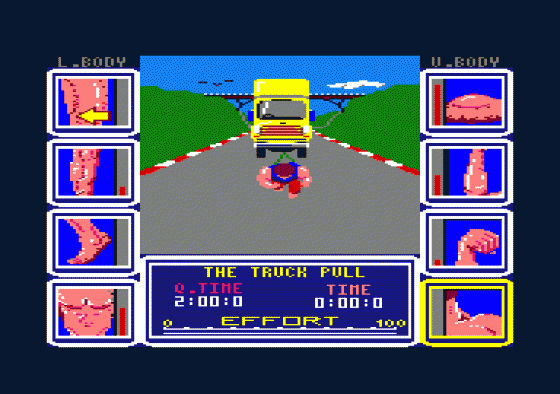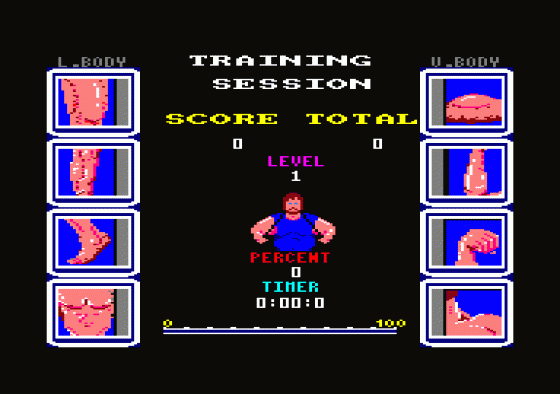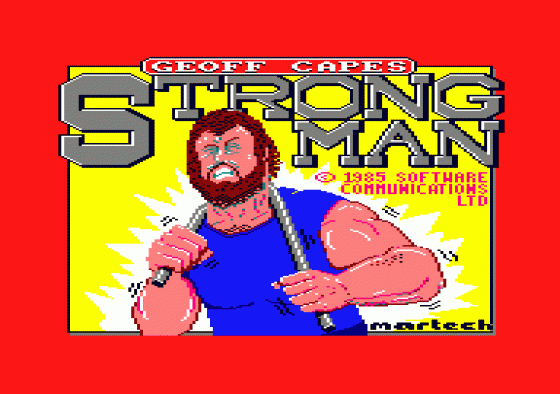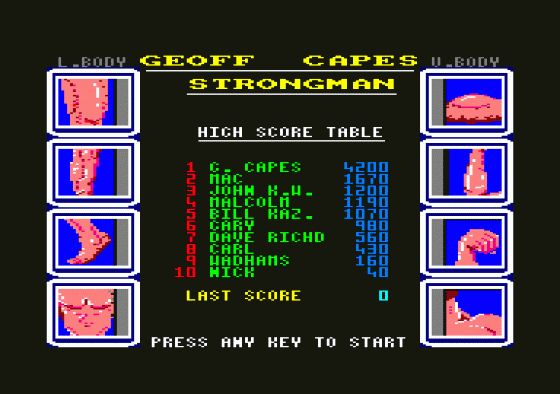
Computer Gamer
 1st November 1985
1st November 1985
Categories: Review: Software
Author: Tony Hetherington
Publisher: Martech
Machine: BBC/Electron
Published in Computer Gamer #8
Geoff Capes Strongman is the first sports simulation to use icons. Tony Hetherington investigates.
Geoff Capes Strongman
Geoff Capes Strongman, according to Martech, is a sports simulation where frantic joystick waggling is replaced by strategy and timing.
The game is based on the events that face Geoff every time he competes in strongman tournaments. Now it's your chance to flex your biceps in this icon-driven challenge.
Six gruelling events from the challenge but before you start pulling trucks and chopping logs a bit of training is required.

This takes the form of 10 seconds of joystick bashing in which you try and accumulate as much energy as possible, which is then allocated to the eight main muscles. A coloured bar next to each of the muscle icons represents the amount of energy allocated to it and, if during an event this reaches zero, Geoff stumbles and the game is over.
The icons are arranged down the sides of the screen display and represent the upper leg, lower arm, upper leg, lower leg, torso, shoulders, hands and feet. In between these muscular icons are the effort bar, score, time and qualifying time displays and a graphics window showing the current event.
The Events
Six gruelling events form the strongman challenge each with a qualifying time which must be met before you can attempt the next. Complete all six and the sequence is repeated but with tougher times to beat.

The events which consist of the truck pull, car roll, log chopping, barrel loading, sumo wrestling and fairground bell fall into three distinct types, each with a unique way of controlling Geoff.
The truck pull and car roll are both icon-driven in which the players must accurately follow a sequence of muscle movements by selecting them with a joystick just after the appropriate icon flashes. Luckily these events are saved from becoming a simple game of Simon by literally the effort you have to put into it. The amount of effort exerted by Geoff is represented by a bar at the bottom of the screen. The more effort you allocate (up to 100%) the faster the muscles move and the more likely you are of beating the qualifying time. However, using more effort also increases the speed of the sequence of icon flashes which makes it harder to keep up and will no doubt lead to mistakes. Your problems are aggravated by the fact that the more effort you use, the quicker the selected muscles will tire.
This is shown by a loss of the muscle's energy and, snce the game ends if just one muscle is exhausted, you have to carefully balance the effort you use and your own ability to keep up with the sequence in order to beat the qualifying time with enough muscle power left to tackle the next event.

Luckily you get an energy top-up after each event but wasting of muscle power will leave you floundering in a later event.
To add moreto your problems the amount of effort that is required will change during the event. For example, rolling the car that has just dropped on an oriental gentleman will require a lot of effort to lift before a sustained push to roll it over. Similarly, all the effort in the truck pull comes at the start as you fight to get it moving. Once it's rolling, less effort is required as long as a steady rhythm is maintained.
Finding the right rhythm is the key to success in the "joystick timed" events.
In the fairground bell event, the player controls the movements of the legs to find the optimum speed at which Geoff should approach the bell before hitting it with the hammer to, hopefully, send it to the top. Pushing the joystick left to right imitates a step with that leg but only if it matches the timing determined by the effort used. If you're too early with your step then the muscles will lose energy but you won't move. If you're too late, you'll take your step but you will have lost valuable time.
Barrel loading adds to the problems by introducting up and down movements as well as Geoff picks up a barrel before walking up some stairs to throw it into the back of the lorry. Then it's back down the stairs for the other four barrels.
Sumo Wrestling mixes the problems of synchronising your leg movements with the problems faced by an aggressive opponent. Both of you are trying to force the other out of the ring. To do this, you must patiently await an opening before using a surge of effort to force him out. Timing is crucial as any mistake could be costly.
Finally, the log chop poses a completely different problem of cutting through a block of wood in the shortest possible time.
The amount of effort you use controls the speed that the axe passes along the log whereas a press of the joystick button will send it crashing onto the log. The log is made up of blocks of three different types of wood. Soft wood will be cut by a single blow whereas hardwood and knots requre two or three chops to remove them. Consequently, to achieve a good time you will have to set the effort and therefore the speed of the axe at a level which is both fast enough to beat the qualifying time but also slow enough to allow you time to pick the best way through the log.
Conclusions
Geoff Capes Strongman presents joystick athletes with a new challenge of six rather different events which are presented in an unusual way.
While the program isn't startling in its graphics, which are at best functional, the game features an enjoyable playing system which captures the excitement and sheer effort of strongman tournaments.
The use of icons works well in the truck pull and car rolling events and provides a welcome change from broken joysticks. While the icons take a back seat in the other events (becoming muscle level indicators) the action remains challenging and unique.
Time alone will tell whether Geoff Capes will become a computer game champion, but it's certainly a game with a lot of muscle.
Geoff Capes Strongman is available for the Spectrum at £7.95, and in C64, BBC, Electron, Amstrad and MSX formats for £8.95.
Other Reviews Of Geoff Capes Strongman For The BBC/Electron
Geoff Capes Strongman (Martech)
A review by Rog Frost (Electron User)
Five Star Games (Beau-Jolly)
A review by Dave E (EUG PD)






